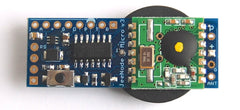JeeNode Micro
€3.50 - €119.50The JeeNode Micro (v3) is the skinny younger brother of the JeeNode - 15 x 47 mm, and just 3.5 mm tall, from using a thin PCB and an extra-flat wireless module. The two ports (not four) of the ATtiny84 processor are enough connectivity for many pint sized applications.
The JeeNode Micro (or JNµ) is aimed at more advanced makers. Software development can be done with the Arduino IDE, with some extra set up, described in this series of Weblogs, see the Arduino-Tiny library and this project for more information. Use an ISP programmer to upload the firmware and note that there is no hardware/software support to simplify debugging.
The JeeNode Micro normally runs at 8 MHz, the RF12 library works fine with the ATtiny84 from 8 MHz down to 4 MHz.
JeeNode Micros are shipped with the RFM12B 868 MHz radio module for use within Europe (select the NoRF versions if you need a different RF module). The Modern Device shop stocks 915 MHz versions at US$ prices.
Version 2/3 added logic for very lower power operation - the RFM12B module can be completely disabled by the ATtiny, enabling the use of slow-startup energy harvesting power sources. Here are the flexible options for selecting the power source to match your application:
- 2.2 .. 3.8 V, fed from a coin cell, 2x or 3x AA, rechargeable or 'dry'. This is the configuration for the lowest quiescent current draw.
- 3.5 .. 5.1 V, fed via dropper diode(s) e.g. 4.2V Lithium, 5.0V from a powered USB hub or a mains adapter. Low quiescent draw but some energy is lost across the dropper diode(s).
- 0.9 .. 5.1 V, fed in through the "PWR" pin with the optional Boost circuit (coin cell must be removed). Higher quiescent current but a stabilised 3.0V logic power rail.
The Direct power JeeNode Micro is pre-assembled. A great option for lowest consumption, battery-powered use. It does not include a voltage regulator - select a power feed in the range of 2.2 .. 3.8V, such as 2x AA batteries, or mount a 3V Lithium coin cell holder in the space provided (the CR2032 coin cell and holder are not included). Alternatively, connecting a 4.2V LiPo battery by adding a series forward-drop diode, or use a 5.0V external supply (check < 5.1V unloaded output) with two series diodes.
The Direct power NoRF is identical, it just omits the RF module so that you can configure a different ISM band and/or different RF Module.
The Boost power JeeNode Micro is pre-assembled and adds a similar circuit to the AA Power Board with 3.0V (not 3.3V) output. Input voltage can now range from as low as 0.9V through to 4.5 V. The quiescent current is a little higher to keep the switching convertor chip alive. The CR2032 coin cell and holder are not included and depending on your power source choice, not required.
The Boost power NoRF is identical, it just omits the RF module so that you can configure a different ISM band and/or different RF Module.
The PCB only variant is the bare board without any components. You’ll need to add your own ATtiny, RF Module, pin headers, and a few other components to create a working JeeNode Micro. This board uses SMD parts of size 0603 – you will need to use proper SMD tools and soldering technique to assemble a JeeNode Micro yourself.
The board announcement was in this Weblog. The documentation and full design details are freely available.


